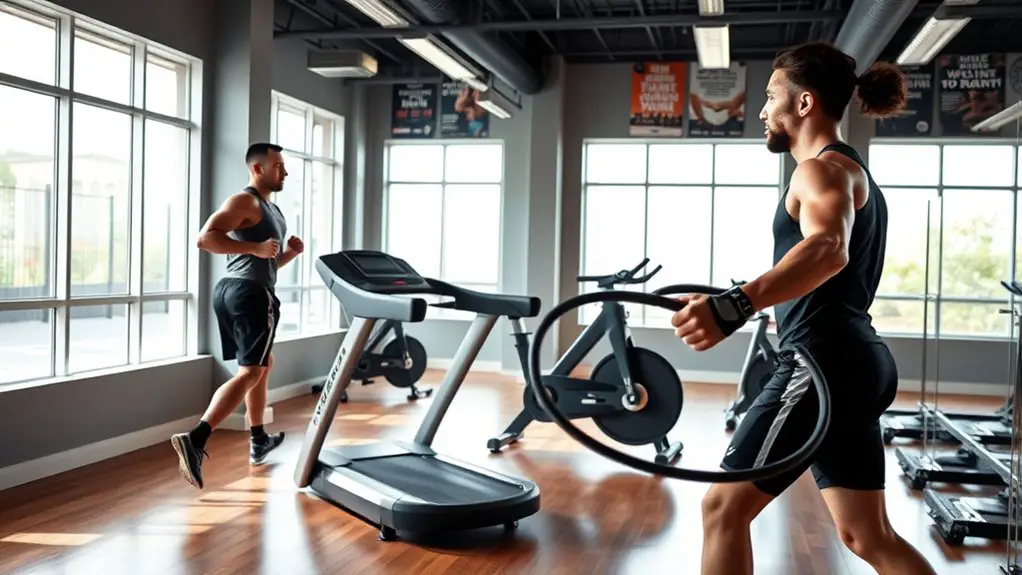The Best Gym Cardio Workouts for Fighters

The best gym cardio workouts for fighters include High-Intensity Interval Training (HIIT), circuit training, and sport-specific drills. These methods boost your endurance, agility, and overall performance in the ring. Steady-state cardio, like jogging or cycling, keeps your heart rate steady while building stamina. Don’t forget plyometric exercises for explosive power. Mix these workouts to keep things exciting and prevent boredom. Keeping that in mind, the next steps will help you enhance your training even further.
High-Intensity Interval Training (HIIT)

When you’re looking to boost your cardio for fighting, High-Intensity Interval Training (HIIT) is a game-changer. This training method combines short bursts of intense activity with periods of rest or lower-intensity exercise, making it incredibly effective for fighters. One of the key HIIT benefits is its ability to enhance your endurance while also improving your power and speed. You’ll find that engaging in HIIT techniques, like sprinting for 30 seconds followed by a minute of walking, can push your limits and elevate your performance.
Not only does HIIT save you time, but it also keeps your workouts exciting and challenging. You can mix in exercises like jumping jacks, burpees, or shadowboxing to keep things fresh. Incorporating jump rope workouts can further enhance your coordination and agility. Embrace the intensity, and you’ll generate explosive results that pay off in the ring. Remember, consistency is key—so make HIIT a regular part of your training routine!
Circuit Training for Fighters
Circuit training is a game-changer for fighters looking to boost their cardio while improving functional movement patterns. By incorporating high-intensity intervals and strategically planned recovery times, you can maximize your endurance and strength in one efficient workout. Get ready to elevate your training and push your limits!
High-Intensity Interval Training
High-Intensity Interval Training (HIIT) is a game-changer for fighters looking to enhance their conditioning and explosive power. With short bursts of intense exercise followed by brief recovery periods, HIIT benefits include improved cardiovascular fitness, increased metabolism, and better endurance—all essential for your performance in the ring. Don’t let common HIIT misconceptions hold you back; it’s not just for elite athletes. Anyone can adapt these workouts to their fitness level, making it accessible and effective for all fighters. Incorporating HIIT into your training routine can lead to quicker results than traditional cardio, keeping your workouts engaging and dynamic. So, gear up, push your limits, and experience the transformative impact of HIIT on your fighting game!
Functional Movement Patterns
As you push your limits with HIIT, incorporating functional movement patterns into your training can take your performance to the next level. Circuit training that focuses on these patterns enhances dynamic flexibility and core stability, essential for fighters. By integrating movements like lunges, squats, and rotational exercises, you’ll improve your overall power and agility in the ring.
Aim for a series of exercises that challenge your body in multiple planes of motion, ensuring you mimic the movements you’ll perform during fights. This not only builds strength but also enhances your coordination and balance. Remember, the goal is to train your body to move as one unit, preparing you for the dynamic demands of competition. Keep pushing, and watch your skills soar!
Recovery and Rest Intervals
While pushing your limits in circuit training, it’s crucial to pay attention to recovery and rest intervals, as they can make or break your performance. Proper recovery helps you recharge your body and mind, so you can hit your next set with full intensity. Incorporate active recovery techniques, like light jogging or dynamic stretches, during your rest intervals to keep your heart rate elevated while allowing your muscles to recover. Aim for 30 seconds to a minute of rest between circuits, adjusting based on your fitness level. Experiment with different rest techniques—like deep breathing or hydration—to find what works best for you. Prioritizing recovery guarantees you not only survive your workouts but thrive in them, enhancing your overall performance.
Sport-Specific Cardio Drills
Sport-specific cardio drills are essential for fighters looking to enhance their performance in the ring or octagon. These drills not only improve your sport endurance but also boost your agility, helping you react faster during fights. Here’s a quick look at some effective drills:
| Drill | Focus Area | Duration |
|---|---|---|
| Ladder Drills | Agility | 15 minutes |
| Shuttle Runs | Speed/Endurance | 10 minutes |
| Jump Rope | Footwork/Agility | 10 minutes |
| Interval Sprints | Sport Endurance | 20 minutes |
| Plyometric Exercises | Power/Agility | 15 minutes |
Incorporating these drills into your routine will enhance not just your stamina but also your overall fight performance. Remember, the more specific your training, the better prepared you’ll be when it counts! Additionally, including 1000 jumps daily can significantly improve your cardiovascular fitness. Keep pushing yourself; you’ve got this!
Steady-State Cardio Workouts

After honing your skills with sport-specific drills, it’s time to balance your training with steady-state cardio workouts. These sessions are essential for endurance building, allowing you to maintain a consistent heart rate over a longer duration. Think of activities like jogging, cycling, or swimming at a moderate pace.
The steady state benefits go beyond just improving your cardiovascular health; they enhance your stamina and recovery times, ensuring you can fight at your best for longer. Plus, the rhythmic nature of these workouts can also help clear your mind, sharpening your focus for intense training sessions ahead.
Incorporate steady-state cardio into your weekly routine, aiming for 30 to 60 minutes a few times a week. This will not only boost your performance but also build a solid foundation for when you ramp up your intensity with more explosive workouts. Stay committed, and you’ll see the difference in your fighting game!
Plyometric Exercises for Agility
To elevate your agility and explosive power, incorporating plyometric exercises into your routine is essential. These jumping drills enhance your ability to move quickly and efficiently, vital for any fighter. Plyometrics focus on explosive movements, helping you develop strength and speed simultaneously.
Here’s a quick overview of effective plyometric exercises:
| Exercise | Benefits |
|---|---|
| Box Jumps | Builds leg power and explosiveness |
| Burpees | Enhances full-body strength and agility |
| Lateral Bounds | Improves lateral movement and stability |
Integrating these exercises into your training regimen will not only boost your performance in the ring but also increase your overall athleticism. Aim for 2-3 sessions per week, and watch your agility soar. Additionally, incorporating alternative workouts can provide effective substitutes for plyometric training, enhancing your fitness journey. Remember, consistency is essential, so stay committed, and you’ll see the results in no time!
Recovery and Active Rest Techniques

Intense training, like plyometric exercises, can take a toll on your body, making recovery and active rest techniques essential for your performance. To truly excel, you need to prioritize recovery just as much as your workouts. Incorporating active recovery days—like light jogging, cycling, or swimming—can boost blood flow and accelerate muscle repair without overexerting yourself.
Foam rolling is another powerful tool in your recovery arsenal. It helps release muscle tightness, improve flexibility, and reduce soreness. Spend a few minutes each day rolling out key areas, like your legs and back, to keep your muscles in top shape. Additionally, maintaining a healthy diet during breaks is important to prevent muscle loss and support your overall fitness journey.
Frequently Asked Questions
How Often Should Fighters Incorporate Cardio Workouts Into Their Training?
To maximize your performance, you should incorporate cardio workouts into your training schedule at least three to five times a week. This cardio frequency helps boost your endurance, keeps your heart healthy, and improves recovery time. Vary your workouts to include high-intensity intervals and steady-state sessions for ideal results. Don’t underestimate the power of cardio; it can elevate your game and prepare you for the challenges ahead. Stay consistent, and you’ll see progress!
What Are the Best Warm-Up Exercises Before Cardio Sessions?
Before diving into cardio sessions, it’s essential to warm up properly. Start with dynamic stretches like leg swings and arm circles to increase blood flow. Incorporate mobility drills such as hip openers and torso twists to enhance your range of motion. These exercises not only prepare your body but also reduce the risk of injury. So, make sure you take this time to warm up; you’ll feel more energized and ready to tackle your workout!
Can Cardio Workouts Help in Weight Management for Fighters?
Absolutely, cardio workouts can be a game-changer for weight management. They not only support weight loss by burning calories but also enhance your endurance improvement, making you more efficient in your training. When you incorporate various cardio exercises, you’ll keep your metabolism revved up and shed those extra pounds. Staying consistent with your cardio routine can help you achieve your goals, boost your energy levels, and ultimately elevate your performance. Keep pushing!
How Can Fighters Avoid Injuries During Cardio Workouts?
You might think cardio workouts are just about pushing your limits, but injury prevention is key. To avoid injuries, focus on proper form and listen to your body. Incorporate recovery techniques like stretching and foam rolling into your routine. Gradually increase intensity, and don’t skip rest days—your muscles need time to recover. Staying hydrated and cross-training can also help keep you safe while maximizing your cardio benefits. Remember, smart training leads to lasting progress!
What Nutrition Should Be Consumed Post-Cardio for Recovery?
After your cardio session, it’s vital to focus on recovery. You should prioritize protein timing; aim to consume a protein-rich meal or shake within 30 minutes. This helps repair muscles and boosts recovery. Don’t forget hydration strategies, too! Replenishing lost fluids is essential for ideal performance. Combine electrolytes with water to restore balance. By taking these steps, you’ll enhance your recovery and keep your energy levels high for your next workout!





